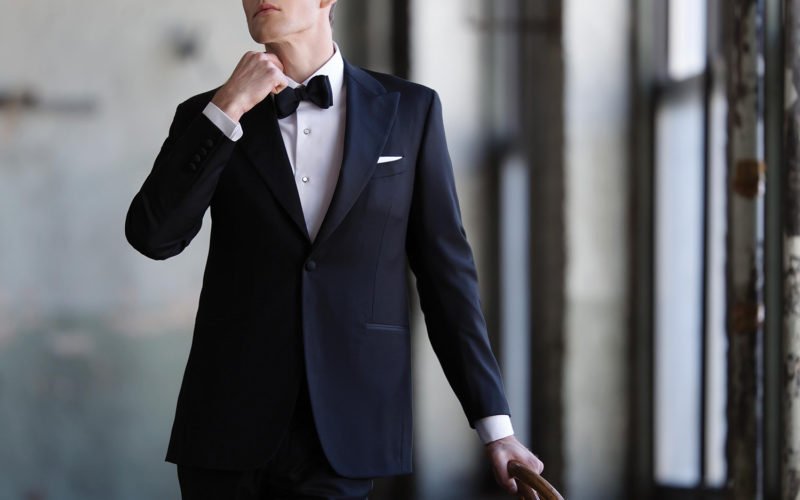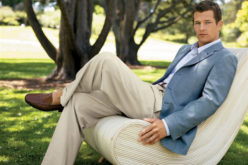Q. I have a party coming up that has the wording “black-tie/festive attire.” What exactly does that mean? Do I just buy a red bow tie to go with my own tuxedo?
A. This is a common confusion. Classic black-tie dressing has a rather strict set of rules, and I have always advised following them faithfully. However, adding “festive attire” to an invitation allows you to be as creative as you like.
As always, I am pleased to hear of any man NOT planning to rent a tuxedo. I have never understood what would prompt a man who has arrived at the level of achievement where he is invited to black-tie events to rent his outfit for the evening. His wife or date is resplendent in her most elegant gown or newest cocktail dress. She wears the finest jewelry she owns (or can borrow), and he comes in a third-rate rental getup that some high school senior might have worn last week to his prom.
When planning to adjust your traditional tuxedo to create a less formal and more festive version, you need to know what defines the formal one.
For a classic black-tie combination, the suit is always black and the shirt is always white with vertical pleats and with French cuffs.
In summer, the jacket may be white, all else remains the same. Suits are fashioned in one of three different collar and lapel styles: shawl, peaked, or notched. Lapels are either made of satin, a silk-like, smooth, glossy fabric, or of grosgrain (also known as faille and pronounced“file”), a heavy, ribbed fabric resembling a twill.
There are two types of closings – single-breasted and double-breasted. The dapper double-breasted jacket is kept buttoned at all times; it should not be your first and only evening suit, because it will come and go in style. It does have one advantage, though, that many men like: the necessity to wear a cummerbund is eliminated. With or without a cummerbund, do not wear a belt. Trousers (made of fabric that matches the jacket) have a ribbon down the outside of the leg that matches the lapel material.
An important note on formal trousers: they never have a cuff.
SO, how does this become festive? Your idea of wearing a red bowtie, though somewhat on the obvious side, is perfectly acceptable. Still, I think you can depart a bit further and choose an accessory or two that will make more of a fun, and sophisticated, sartorial statement. Here are a few possibilities.
- SHIRTS. The totally correct shirt for black-tie dressing has a standard turned-down collar, but the wing collar is so flattering that it has become a popular departure. I would avoid any nontraditional black-tie shirts, that is nonwhite or those that have buttons. The less-common fly-front (covered placket) formal shirt is acceptable, but takes away your opportunity to choose attractive studs.
- CUFF LINKS. All formal shirts have French cuffs that require cuff links and these present a wide range of options. Don’t just stay with black or white. The links generally are of simple design, usually matching the studs: in gold, platinum, gold-plate, colored enamel, opaque stones such as onyx, lapis lazuli, jade, or mother-of-pearl. Or, they might be the less-expected silk knots that come in black and also in colors. These are available at better stores and are extremely inexpensive. Many well-dressed men who often wear black-tie attire favor silk knots over expensive cuff links. It is a unique, chic look.
- SUSPENDERS. Button-on suspenders (“braces”) are always worn with formal trousers. As with bow ties, they absolutely should not be clip-ons. “Festive” allows many choices here, including black-and-white polka dots and other colored patterns that will only show when you want them to.
- BOW TIES are traditionally made of the same black fabric as the lapels, but they can be your one or primary element of originality and difference. A black watch tartan (dark green, navy, and black plaid) bow tie is a nice holiday-season departure that would work for festive attire. And, if you are not skilled at tying your own, I would urge you to start practicing now.
- POCKET SQUARES. Here again you can go festive or leave that to your other accessories. Choose silk in a bright, dashing touch of color or a plain white linen.
- VESTS. A distinctive way to set yourself apart from the crowd is to choose a vest in a contrasting fabric instead of the standard black cummerbund, perhaps in a black or a colored silk brocade. It could even be double-breasted under your single-breasted tuxedo jacket.
- SOCKS. This is not the place to introduce “festivity” with the new colored or patterned socks. Socks worn with formal evening clothes are always black, lightweight (ideally silk), and to-the-calf or over-the-calf.
- BOUTONNIERE. Perhaps the least expensive and easiest way to create a festive look is to add a fresh flower to your lapel.
Don’t go overboard. That is, only one or two special items, not several at once. And, do not confuse festive with inappropriate. Actually, for festive attire, all a man really needs is one interesting item that shows that he tried.
Please send your men’s dress and grooming questions to MALE CALL: Lois.Fenton@prodigy.net









